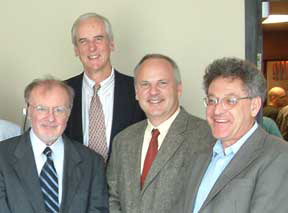Physics labs consolidate to build a new accelerator
By Bill Steele

Two of Cornell's major research organizations have combined into a single entity, reflecting the increasingly interdisciplinary nature of their work, their mutual interest in Cornell's particle-accelerator facilities and their plans to develop a new linear accelerator in the coming years. The Laboratory of Elementary Particle Physics (LEPP) and the Cornell High Energy Synchrotron Source (CHESS) have joined to become the Cornell Laboratory for Accelerator-based Sciences and Education (CLASSE, pronounced "class").
"We are positioning ourselves to better address opportunities for the future in particle physics and X-ray science," said Maury Tigner, the Hans A. Bethe Professor of Physics Emeritus and former director of LEPP, who will chair the directorate of the new organization. The directorate also includes Betty Jane Bortz, administrative director, and David Rice, technical director. Sol Gruner, the John L. Wetherill Professor of Physics and former director of CHESS, will be director of X-ray science; James Alexander, professor of physics, will be director for particle physics.
The consolidation, Tigner said, reflects the fact that both laboratories use the same tools, especially the Cornell Electron Storage Ring (CESR). CESR is used in particle physics research and serves as a source of high-energy X-rays for a variety of uses in physics, materials science and biology. CLASSE will manage the development of the Energy Recovery Linac (ERL), an innovative linear accelerator to be built as an extension of CESR. Charles Sinclair, LEPP senior research associate, will lead the prototyping of the ERL and also serve as member of the directorate. The ERL will provide more and "brighter" X-rays that can be focused into beams as narrow as 1 nanometer (a billionth of a meter), and fired in pulses as short as tens of femtoseconds, making it possible to make movies of chemical reactions. Construction, estimated to cost around half a billion dollars, is scheduled to begin at the end of the decade.
The consolidation was formally announced July 7 at a gathering of about 100 Cornell physicists in Call Auditorium in Roberts Hall. Guest speaker Jochen Schneider, director of photon sciences at the Deutsches Elektronen-Synchrotron in Hamburg, Germany, outlined the broad range of possible uses of high-energy X-rays, which include determining the structure of proteins, examining the interior of living tissue in incredibly high resolution and exploring the behavior of atoms in semiconductors.
Alexander reported that for most of the next 10 years Cornell particle physicists will be working with the Large Hadron Collider, now under construction at the CERN laboratory in Geneva, Switzerland, and later with the proposed International Linear Collider, as part of large international efforts to explore physics at smaller scales of time and space than ever before. The goal, he said, is to go beyond the "standard model," a description of elementary particles that no longer addresses all the phenomena that particle physicists and astrophysicists are observing. LEPP physicists also are involved in the development of detectors for the Large Hadron Collider and both detectors and accelerator technology for the International Linear Collider.
To close the event, Robert Richardson, Cornell vice provost for research, officially declared CLASSE into existence.
Media Contact
Get Cornell news delivered right to your inbox.
Subscribe